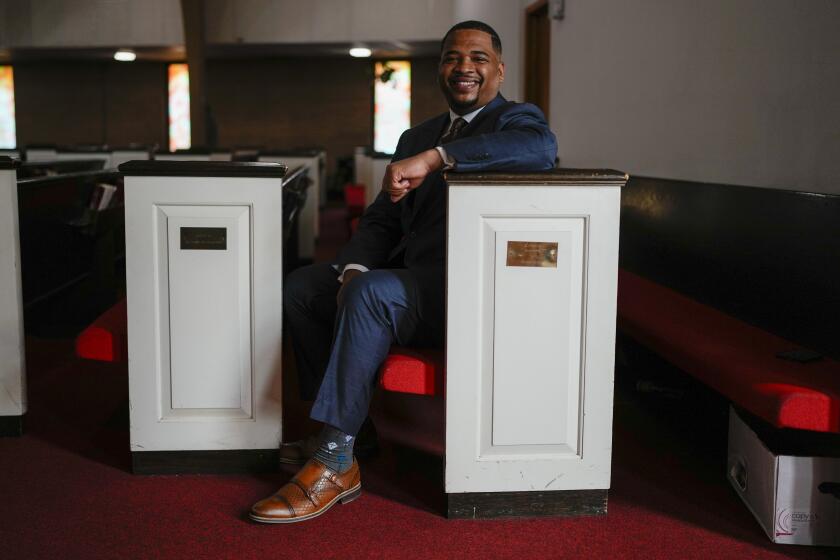Anasazi Mummified Some of Their Dead, Anthropologist Contends
In the late 1800s and early 1900s, archeologists and plunderers excavated mummies of dozens of ancient Anasazi Indians buried in caves and rock shelters in southeast Utah and other Four Corners states. Experts have believed that they were mummified naturally by the area’s dry climate.
But a Peruvian physician-anthropologist says that decades-old photographs and reports of two mummies from Utah and Arizona provide evidence that the Anasazi sometimes mummified their dead intentionally.
“The Anasazi practiced artificial mummification,” Guido Lombardi said at the recent annual meeting of the Paleopathology Assn. “This suggests the Anasazi had a more complicated society than previously thought.”
The Anasazi--ancestors of modern Hopi, Zuni and other Pueblo tribes of the Southwest--have been viewed as an egalitarian society, but intentional mummification suggests that some Anasazi held a higher rank than others, said Lombardi, an anthropology doctoral student at New Orleans’ Tulane University.
“This is the first time I’ve seen this evidence brought to the scientific community,” said University of Nebraska anthropologist Karl Reinhard, who wrote a chapter on Southwest mummies in the book “Mummies, Disease and Ancient Culture.”
After hearing Lombardi, Reinhard said: “I’m going to have to rewrite the chapter,” which now says, “Mummification was not intentional for most North American prehistoric cultures.”
Utah State archeologist Kevin Jones expressed skepticism: “I would not be surprised to find there may have been some attempts at manipulating a corpse to preserve it. But I don’t believe from what I’ve heard there’s very much evidence to go on.”
Evidence of intentional mummification was convincing to Bernardo Arriaza, an anthropologist at the University of Nevada, Las Vegas, and organizer of the Third International Congress on Mummy Studies, which will meet in Chile in May.
“To me it’s not a surprise,” Arriaza said, noting that mummification was practiced by ancient Alaskan Aleuts and by South American prehistoric cultures.
Intentional mummification by the Anasazi shows the practice occurred throughout the Western Hemisphere, said Lombardi, a physician who previously studied mummies in his native Peru.
Jones said the Anasazi lived in the Four Corners from the time of Christ to the late 1200s or early 1300s, when they abandoned southern Utah and Colorado’s Mesa Verde and moved farther south.
In the 1890s, Richard Wetherill--a rancher, explorer, amateur archeologist and artifact plunderer--led expeditions into Utah’s Grand Gulch, 30 miles southwest of Blanding.
In a cave there, he found a mummy named Cut-in-Two Man because the body had been cut through the hips and abdomen, then sewn together with twine of braided human hair. Glass-plate photos taken by Charles Lang during Wetherill’s expeditions are stored at Tulane University, where Lombardi studied them.
He displayed photos of Cut-in-Two Man during the meeting. Wetherill once wrote Cut-in-Two Man was the victim of a knife wound, and the sewing was a crude surgical attempt to save him.
Lombardi said it is more likely that Cut-in-Two Man was eviscerated and sewn together after death to mummify his remains. “No one would survive a wound like that,” Lombardi said, adding that Cut-in-Two Man also “was much better preserved than other mummies.”
He also noted that Wetherill found dismembered arms and legs from other people placed around the mummy like offerings, also suggesting an intentional ceremonial ritual.
Winston Hurst, an archeologist in Blanding, agreed that Cut-in-Two Man wasn’t a surgical patient, but added: “You’d have a hard time proving they [the Anasazi] were eviscerating for intentional mummification.”
Lombardi also studied old photos and archeologist Alfred Kidder’s 1919 report on a mummified “trophy head” found in a cave in northeast Arizona.
The skull had been removed from the head, then the face and scalp sewn back together, Lombardi said. The head also had an elaborate hairdo and face painting, indicating a case of intentional mummification largely overlooked since 1919, Lombardi said.
Jones, however, said intentional mummification “is not necessarily the only interpretation for a skinned head and a guy sewn back up.”
He cited controversial arguments that the Anasazi may have practiced cannibalism. Jones said the mummies should be studied directly to confirm claims that preservation was intentional.
Lombardi agreed. He believes the trophy head is stored at Peabody Museum in Massachusetts, while Cut-in-Two Man may be at New York’s American Museum of Natural History.
Reinhard said sophisticated post-mortem processing of the head and Cut-in-Two Man both indicate intentional mummification and “ceremonial use of the dead.”
Intentional mummification “is highly probable,” agreed pathologist Arthur Aufderheide, a mummy expert at the University of Minnesota in Duluth.
Lombardi said Wetherill’s view that Cut-in-Two Man underwent crude surgery reflected his biased opinion that native people were incapable of sophisticated mummification.
“We failed to appreciate the richness and complexity of these early groups,” said University of New Mexico anthropologist Jane Buikstra.
More to Read
Start your day right
Sign up for Essential California for news, features and recommendations from the L.A. Times and beyond in your inbox six days a week.
You may occasionally receive promotional content from the Los Angeles Times.






